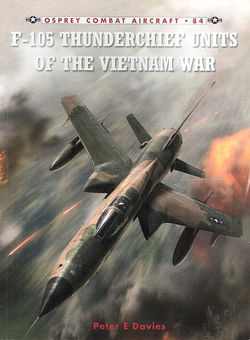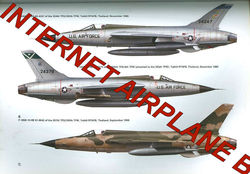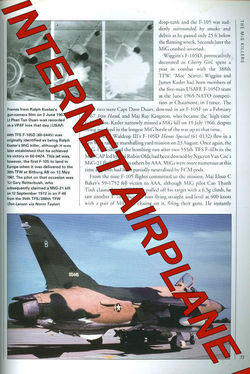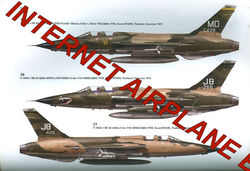OSPREY COMBAT AIRCRAFT 84 F-105
THUNDERCHIEF UNITS VIETNAM WAR USAF TFW FIGHTER-BOMBER WILD WEASEL
SOFTBOUND
BOOK by PETER E. DAVIES
FROM
NUKES TO NAPALM
THE
WAR IN LAOS
ROLLING
THUNDER
STRIKES
AND LOSSES
MIG-KILLERS
WILD
WEASELS
PRATT
& WHITNEY J-75 JET ENGINE
NOSE
LANDING GEAR
MAIN
LANDING GEAR
F-105D
(457th TFS THUNDERSTICK II MODIFICATIONS)
BOMB
BAY AND TANK
PYLONS
THUD
IN COMBAT (VIETNAM WAR, 4TH TFW, ROLLING THUNDEER, NVAF SAM, MIG-17, 388TH TFW,
KORAT RTAB, 44TH TFS, 355TH TFW TAKHLI RTAB)
GENERAL
ELECTRIC M61 VULCAN 20mm GATLING CANNON
AIM-9
SIDEWINDER MISSILE RAILS
AGM-12
BULLPUP AIR-TO-SURFACE MISSILE
Mk82
BOMB WITH DAISEY CUTTER FUSE EXTENDER
F-105
EJECTION SEAT
CENTERLINE
BOMB RACK
EXTERNAL
STORES LOADING
ATTACKING
THE PAUL DOUMER BRIDGE
THE
RED RIVER VALLEY / RIVER RATS (333RD TFS, 354TH TFS, 357TH TFS LICKING DRAGONS,
544TH TFS)
GOING
DOWNTOWN / THE THUD IN SOUTHEAST ASIA (RYAN�S RAIDERS, KORAT RTAFB, COMMANDO
NAIL, F-105F COMBT MARTIN, WILD WEASEL EF-105F, AGM-45 SHRIKE, GD AGM-78A
STANDARD ARM, 355TH TFW, 17TH WWS, LINEBACKER II, 23TH TFW, 12TH TFS, 357TH
TFS, ROUTE PACKAGES, MER MULTIPLE EJECTOR RACK, Mk82 GP BOMB, Mk117 GP BOMB,
GROUND HANDLING TOWING PROCEDURE, GROUND SAFETY PINS)
WILD
WEASEL (KORAT
17TH
WWS LINEBACKER, PROJECT LOOK ALIKE, AN/ALR-31 SEE-SAMS RWR. R-14A NASARR RADAR
UNIT MODES, GENERAL ARRANGEMENT DRAWINGS, FUEL QUANTITY TABLE, QRC-128 JAMMING
EQUIPMENT, WILD WEASEL FRONT AND BACK INSTRUMENT PANELSF-105G, AN/ALQ-101 POD,
QRC-380)
COLONEL
JACK BROUGHAM
355TH
TFW TAKHHLI AB, KORAT RTAB, F-105F TWO-SEATER
F-105D
& F COCKPIT LAYOUTS
THROTTLE
QUADRANT, CONTROL STICK & SURVIVAL SEAT PACK KIT
F-105D
COLOR COCKPIT PHOTOS
F-105G
WILD WEASEL COLOR COCKPIT PHOTOS (FRONT & REAR)
F-105D,
F AND G RADAR INSTALLATION
F-105F
TWO-SEATER COLOR PHOTOS (GEORGIA ANG, 465TH TFS)
F-105F
(457TH TFS AIR FORCE RESERVE)
F-105G
WILD WEASEL
------------------------------------------------------------------------------------------------------------
Additional
Information from Internet Encyclopedia
The
Republic F-105 Thunderchief was a supersonic fighter-bomber used by the United
States Air Force. The Mach 2 capable F-105 conducted the majority of strike
bombing missions during the early years of the Vietnam War; it was the only
U.S. aircraft to have been removed from combat due to high loss rates.
Originally designed as a single-seat, nuclear-attack aircraft, a two-seat Wild
Weasel version was later developed for the specialized Suppression of Enemy Air
Defenses (SEAD) role against surface-to-air missile sites. The F-105 was
commonly known as the "Thud" by its crews.
The
F-105 was a mid-wing monoplane with a 45� swept wing and tail surfaces. The
single engine was fed by two intakes in the wing roots, leaving the nose free
for a radome housing the multi-mode radar. Its fuselage provided room for 1,184
US gallons (4,480 L) of fuel and an internal bomb bay. The bomb bay measured 15
feet 10 inches (4.83 m) by 32 in (0.81 m) by 32 in (0.81 m); it was originally
to carry a single nuclear weapon but typically held an additional 350 US gal
(1,300 L) fuel tank. It featured four under-wing and one centerline pylon; the
two inner wing and centerline pylons were capable of accepting fuel from 450
and 650 US gal (1,700 and 2,500 L) drop tanks. Two outer dry stations were
wired for missiles or bombs. One M61 Vulcan (initially designated T-171E3) 20
mm 6-barrel Gatling-style cannon was installed in the left side of the nose. A
short-range AIM-9 Sidewinder air-to-air missile could be carried on each of the
outer wing pylons.
The
F-105 was designed primarily for low-level interdiction and its low-altitude
speed was its greatest asset when dealing with enemy fighters such as the
MiG-17/J-5s and MiG-21. The F-105 managed 27.5 air-to-air victories. Based on
combat experience, the F-105D was updated with a better ejection seat,
additional armor, improved gun sights, and Electronic Counter Measures (ECM)
pods on the wings
As
a follow-on to the Mach 1 capable F-100, the F-105 was also armed with missiles
and a cannon; however, its design was tailored to high-speed low-altitude
penetration carrying a single nuclear weapon internally. First flown in 1955,
the Thunderchief entered service in 1958. The F-105 could deliver a greater
bomb load than the large strategic bombers of World War II such as the B-17
Flying Fortress and B-24 Liberator. The F-105 was one of the primary strike
bombers of the Vietnam War; over 20,000 Thunderchief sorties were flown, with
382 aircraft lost (nearly half of the 833 produced) including 62 operational
losses. Although less agile than smaller MiG fighters, USAF F-105s were
credited with 27.5 kills.
During
the war, the single-seat F-105D was the primary aircraft delivering the heavy
bomb loads against the various military targets. Meanwhile, the two-seat F-105F
and F-105G Wild Weasel variants became the first dedicated Suppression of Enemy
Air Defenses (SEAD) platforms, fighting against the Soviet-built S-75 Dvina
(NATO reporting name: SA-2 Guideline) surface-to-air missiles. Two Wild Weasel
pilots were awarded the Medal of Honor for attacking North Vietnamese
surface-to-air missile sites, with one shooting down two MiG-17s the same day. The
dangerous missions often required them to be the "first in, last
out", suppressing enemy air defenses while strike aircraft accomplished
their missions and then left the area.
The
Thunderchief was the largest single-seat, single-engine combat aircraft in
history, weighing approximately 50,000 pounds (23,000 kg). It could exceed the
speed of sound at sea level and reach Mach 2 at high altitude; The F-105 could
carry up to 14,000 lb (6,400 kg) of bombs and missiles. The Thunderchief was
later replaced as a strike aircraft over North Vietnam by both the McDonnell
Douglas F-4 Phantom II and the swing-wing General Dynamics F-111 Aardvark.
However, the "Wild Weasel" variants of the F-105 remained in service
until 1984 after being replaced by the specialized F-4G "Wild Weasel
V".
Enthusiastic
at first, the United States Air Force awarded Republic with a contract for 199
aircraft in September 1952. However, by March 1953, the USAF had reduced the
order to 37 fighter-bombers and nine tactical reconnaissance aircraft, citing
the approaching end of the Korean War. By the time the F-105 mock-up had been
completed in October 1953, the aircraft had grown so large that the Allison J71
turbojet intended for it, was abandoned in favor of an even more powerful Pratt&
Whitney J75. Anticipating a protracted development of the engine, it was
expected that the first aircraft would use the smaller Pratt & Whitney J57.
Near the end of 1953, the entire program was canceled by the USAF due to a
number of delays and uncertainties regarding the aircraft, however on 28 June
1954, the USAF officially ordered 15 F-105s (two YF-105As, four YF-105Bs, six
F-105Bs and three RF-105Bs) under the Weapon System designation WS-306A.
In
March 1956, the USAF placed a further order for 65 F-105Bs and 17 RF-105Bs. In
order to conduct the nuclear mission, an MA-8 fire control system, AN/APG-31
ranging radar, and K-19 gunsight to allow for toss bombing was integrated. The
first pre-production YF-105B flew on 26 May 1956. Five of the F-105C trainer variant
were added to the procurement plan in June 1956, before being canceled in 1957.
The RF-105 reconnaissance variant was canceled in July 1956. The first
production F-105B was accepted by the Air Force on 27 May 1957. In June 1957
Republic Aviation requested that the F-105 be named Thunderchief, continuing
the sequence of the company's Thunder-named aircraft, e.g. P-47 Thunderbolt,
F-84 Thunderjet, and F-84F Thunderstreak; the USAF made the name official a
month later.
To
fill the Air Force requirement for all-weather attack, Republic proposed the
F-105D variant in 1957. It added more advanced navigation system, and improved
cockpit displays for adverse weather operation. The ability to carry the TX-43
nuclear weapon was also added. The RF-105 reconnaissance development was also
restarted; now based on the F-105D. The first D-model took its maiden flight on
9 June 1959. Plans to build over 1,500 F-105Ds were cut short when the
Secretary of Defense Robert McNamara decided to equip no more than seven combat
wings with the type. In November 1961, production was cut in favor of the Air
Force adopting the Navy's F-4 Phantom II, and in the longer term, the General
Dynamics F-111 Aardvark of the TFX program.
The
final 143 Thunderchiefs built were of the two-seat F-105F trainer variant.
Based on the F-105D, this model was 31 inches (79 cm) longer to provide room
for the rear cockpit, otherwise the aircraft had similar flight performance to
the preceding F-105D. A total of 833 F-105s were completed before production
ended in 1964. The F-105 had been designed for a short nuclear campaign leading
to shortcomings that became evident in a lengthy conventional war that included
a poor hydraulics layout and fuel tanks that were not self-sealing. Subsequent
upgrades improved the reliability and weapons capacity of the existing F-105Ds.
In response to the surface to air missile (SAM) threat experienced in the skies
above Vietnam, dozens of F-105Fs were converted into anti-radar "Wild
Weasel" aircraft, culminating with the F-105G
The
rear cockpits of several two-seat F-105Fs were modified under project Commando
Nail with an R-14A radar and a radar scope that offered high resolution. These
aircraft were used for all-weather and night low-level strikes against
especially dangerous targets by a unit from the 13th Tactical Fighter Squadron
(1966�1975) dubbed "Ryan's Raiders" starting in April 1967. Some of
these aircraft were later converted to the Wild Weasel III standard.
In
an effort to thwart MiG attacks, several F-105Fs were also fitted with
Hallicrafters QRC-128 communication jamming system under project Combat Martin.
The North Vietnamese interceptor force followed Soviet air-defense doctrine,
with pilots under rigid direction of ground controllers over radio links. The
QRC-128, nicknamed "Colonel Computer", filled up the rear cockpit of
the F-105F. It bounced voice communications over the radio channel back out
after a delay, resulting in an obnoxious garble. However, the first time the Combat
Martin was used, the US National Security Agency (NSA), in charge of US
strategic signals intelligence, ordered the Air Force to cease and desist
immediately, since the NSA believed that the intelligence obtained by
monitoring the channels outweighed the benefits of jamming them. Some of these
aircraft were eventually brought to the Wild Weasel III standard.
Experience
in Vietnam demonstrated the need for a better visual and blind bombing
capability. In March 1968, the Air Force ordered development of a new
bombing/navigation system incorporating a LORAN receiver, an inertial
navigation system, and solid-state electronics for the R-14A radar. Persistent
problems with the AN/ARN-85 LORAN receiver resulted in substitution of the
AN/ARN-92. This was housed in a long, raised dorsal spine. Known as
Thunderstick II aircraft, these F-105s could achieve a bombing circular error
of probability (CEP) of 50 feet (15 m) from an altitude of 15,000 ft (4,600 m).
Although the first Thunderstick II aircraft flew in 1969, they were never used
in Vietnam. A total of 30 F-105Ds received this modification.
In
1965, the USAF began operating two-seat F-100F Super Sabres specially equipped
for Suppression of Enemy Air Defenses mission in Vietnam. Nicknamed the Wild
Weasel, these aircraft achieved a number of victories against North Vietnamese
surface-to-air missile radars. The second crew member was a Navigator trained
as an Electronic Warfare Officer (EWO) to decipher sensor information and guide
the pilot towards the targets. However, the F-100F was an interim solution, its
limited payload often required multiple aircraft to conduct a successful
strike; it also lacked the speed and endurance to effectively protect the
F-105.
The
resulting EF-105F Wild Weasel III (the EF designation was popularly used but
unofficial) supplemented its sensors and electronic jamming equipment with
AGM-45 Shrike anti-radiation missiles and conventional bombs, giving it an
offensive capability lacking in the F-100F. The first of these aircraft flew on
15 January 1966 and they began arriving in Southeast Asia in May, flying their
first mission on 6 June 1966, with five assigned to the 13th TFS at Korat RTAFB
and six more to the 354th TFS at Takhli RTAFB.
In
a typical early mission, a single EF-105F would accompany one or two flights of
F-105Ds to provide protection from enemy ground fire. While this strategy was
effective in reducing F-105D losses, the Weasel aircraft suffered heavy
casualties with five of the first 11 lost in July and August 1966. Attacks into
high-risk environments saw the Weasels operating in "Iron Hand"
Hunter-Killer flights of mixed single-seat and two-seat Thunderchiefs,
suppressing sites during attacks by the strike force and attacking others en
route. In the fall of 1967, EF-105Fs began to be upgraded to the definitive
Wild Weasel Thunderchief, the F-105G.
The
F-105G incorporated a considerable amount of new SEAD-specific avionics,
including an upgraded RHAW system which required a redesign of the wingtips. To
free outboard hardpoints for additional weapons, the Westinghouse AN/ALQ-105
electronic countermeasures were permanently installed in two long blisters on
the underside of the fuselage. Thirty aircraft were fitted with pylons to carry
the AGM-78 Standard anti-radiation missile. On a typical mission, the F-105G
carried two Shrikes on outboard pylons, a single Standard on an inboard pylon
balanced by a 450 US gal (1,700 L) fuel tank on the other side, and a 650 US
gal (2,500 L) centerline fuel tank
In
1964, modified F-105Bs with ballast replacing the cannon, fuselage and wing
reinforcement for aerobatics, and the addition of a smoke generator, briefly
flew with the United States Air Force Thunderbirds demonstration team. After
only six shows, a fatal accident from overstressing the airframe led to the
reintroduction of the F-100 Super Sabre.
By
1964, the F-105B was relegated to USAF Air National Guard (ANG) squadrons. It
was replaced in frontline service by the definitive F-105D whose advanced
NASARR R-14A radar and AN/ASG-19 Thunderstick fire-control system gave it
all-weather capability. The R-14A radar also added a terrain-following radar
capability, while a completely new instrument panel was fitted, replacing
dial-type instrument with vertical tape instruments which were easier to read
in combat. In order to accommodate the new radar, with a much larger radar
dish, the forward fuselage was redesigned, increasing overall length by 16
inches (41 cm).
The
F-105D entered service with the 335th TFS in September 1960, although it was
not fully operational on the F-105D until early 1961. The first overseas F-105
units formed in West Germany in 1961, with the 36th Tactical Fighter Wing at
Bitburg Air Base in May and the 49th Tactical Fighter Wing at Spangdahlem Air
Base in October. Both wings had a primary tactical nuclear strike role for
NATO. The F-105D was also deployed to the Pacific, with the 18th Tactical
Fighter Wing at Kadena in Okinawa converting in 1962 and the 8th Tactical
Fighter Wing converting from 1963.
Meanwhile,
the USAF was gradually changing the anticipated F-105 mission from nuclear
interdiction to conventional bombing. The Look Alike upgrades increased the
aircraft's capacity from four to 16 conventional 750 lb (340 kg) bombs on
underwing and fuselage centerline hardpoints and added the equipment to launch
AGM-12 Bullpup air-to-ground missiles. In June 1961, an F-105D delivered 15,430
lb (7,000 kg) of conventional bombs during a USAF test�at the time a record for
a single-engine aircraft and a payload three times heavier than World War II�s
four-engine heavy bombers such as the Boeing B-17 Flying Fortress and the
Consolidated B-24 Liberator, though aerial refueling would be required for long
missions.








